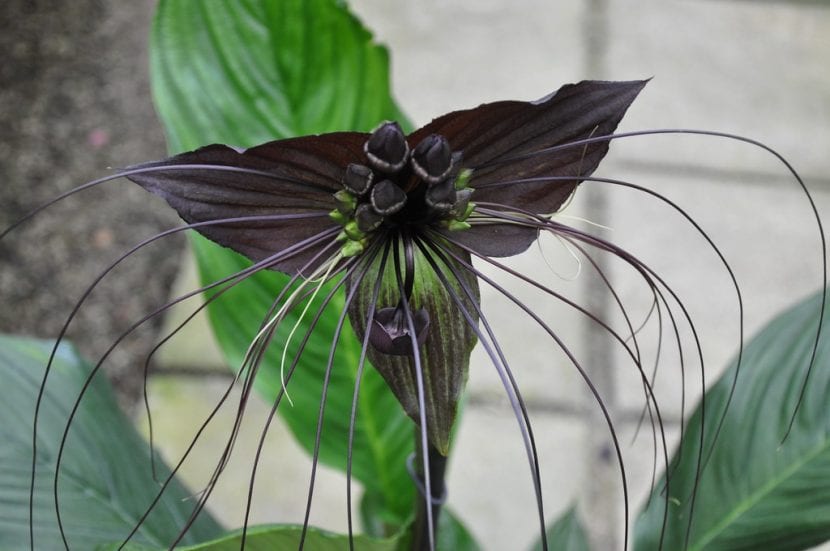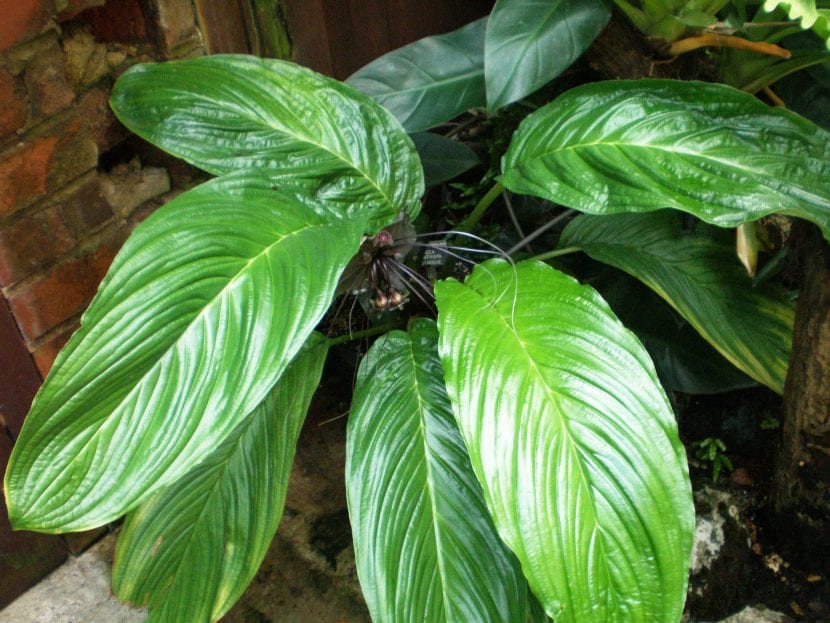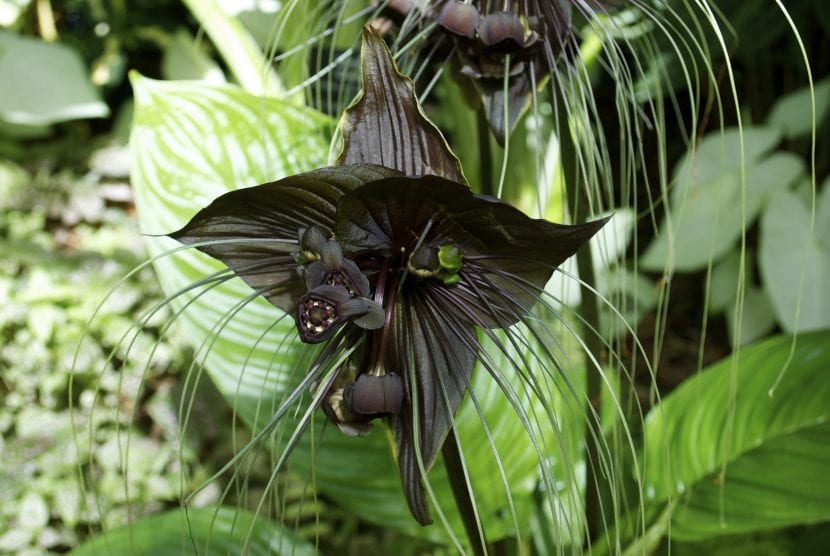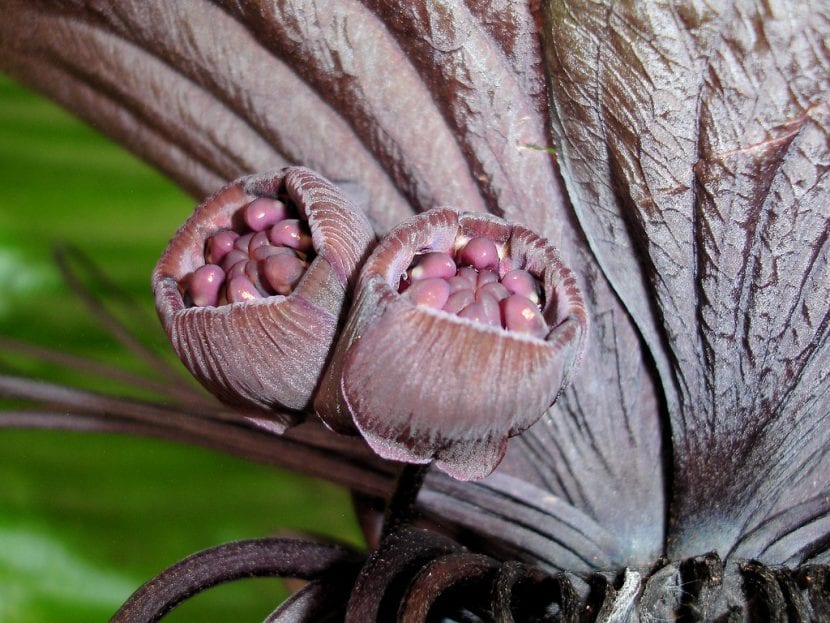
Image - Flickr / douneika
In tropical forests we can find various plants that draw our attention, and one of the most amazing is known as the bat flower. Its scientific name is tacca chantrieri, and it is a herbaceous plant that, as its name suggests, produces flowers that are reminiscent of those animals.
Its beauty is such that from time to time it is seen for sale in nurseries. However, growing and maintaining this precious species is not easy. What can be done to keep it healthy? Coming up next, we tell you.
Origin and characteristics

Image - Wikimedia / Hugo.arg
La tacca chantrieri, known as bat flower, cat whiskers or devil flower, is a perennial rhizomatous herbaceous native to the tropical regions of Southeast Asia, specifically Thailand, Malaysia and southern China. It can reach a height of between 50 and 70 centimeters, and develops simple and erect leaves, with an oblong to oblong-elliptical or oblanceolate shape, with a size of 20-50 long by 7-14cm wide.
The flowers are bisexual, large, about 30-35cm long, dark purple in color, and appear grouped in umbelliform inflorescences. The fruit is a purple, ellipsoid berry, about 4cm long by 1,2cm wide.
What are their cares?
If you dare to have a bat flower specimen, we recommend providing it with the following care:
Climate
So that there are no problems, the ideal would be for the climate to be tropical humid. It is a plant that It needs mild temperatures, between a minimum of 10ºC and a maximum of 30ºC., and a humid environment. In cooler regions, its maintenance is difficult.
Location
- Interior: it must be in a bright room, away from drafts and with high ambient humidity provided by a humidifier for example.
- Body exterior:: whether the climate is appropriate or if you can only have it outside in the spring and summer months, place it in a shady corner, where the sun does not reach directly.
Earth
It must be rich in organic matter, with good water filtration capacity. So that:
- Potted cultivation: add a first layer of claystone (on sale here), and then mix mulch (for sale here) with 20% substrate for acidic plants (for sale here).
- Garden cultivation: the soil must be fertile, light, well drained, and somewhat acidic (pH between 5 and 6.5). If yours is not like that, and as it is a relatively small plant, make a planting hole of about 50 x 50cm, cover its sides with shading mesh and fill it with the mixture of substrates mentioned above.
Irrigation

Image - Wikimedia / Ronincmc
Type of water
Watering is one of the most difficult tasks to master when caring for an exotic plant. First, let's start by talking about the type of water to be used: the most recommended will always be the rain, but since we cannot all have it, other alternatives are bottled water (for human consumption), or somewhat acidic water. The latter must only be achieved when the one that comes out of the tap is undrinkable because it has a lot of lime, diluting the juice of half a lemon in 5l / water, and checking the pH with a meter (for sale here) or with the classic pH strips (on sale here). The pH must be between 4 and 6.5 to be optimal for the tacca chantrieri.
Irrigation frequency
It will depend on the location and the weather, but in general you have to water about 3 times a week in summer and 1-2 weekly the rest of the year. In case of having it in a pot, do not forget to remove the excess water 20-30 minutes after having watered, since otherwise its roots could rot.
What NOT to do
If you want me to be well healthy, it is very important that you avoid doing the following:
- Wet the leaves and flowers (there are other ways to increase the humidity, safer, like the ones we tell you here)
- Keep the plate always full of water
- Plant it in a pot without drainage holes
Subscriber
During all the warm months of the year It must be paid with fertilizers such as guano (for sale here) or the universal (for sale here) following the instructions specified on the package.
Pruning
You just have to cut the dry leaves and the withered flowers.
Multiplication

Image - Flickr / Gertrud K.
La tacca chantrieri multiplies by seeds in spring, following this step by step:
- Fill a pot about 10,5cm in diameter with mulch and 20% perlite.
- Then water conscientiously.
- Then, sow the seeds on its surface, ensuring that they are somewhat separated from each other.
- Finally, sprinkle copper (for sale here), which will prevent fungi from spoiling the seeds, and cover them with a thin layer of substrate.
Keeping the seedbed near a heat source and well watered, they will germinate in about 15 days.
Rusticity
Can't stand cold or frost. Adult and acclimatized specimens can withstand up to 4,5ºC, provided it is for a short time.
What did you think of the bat plant?